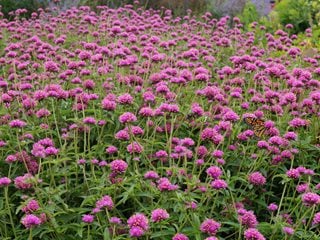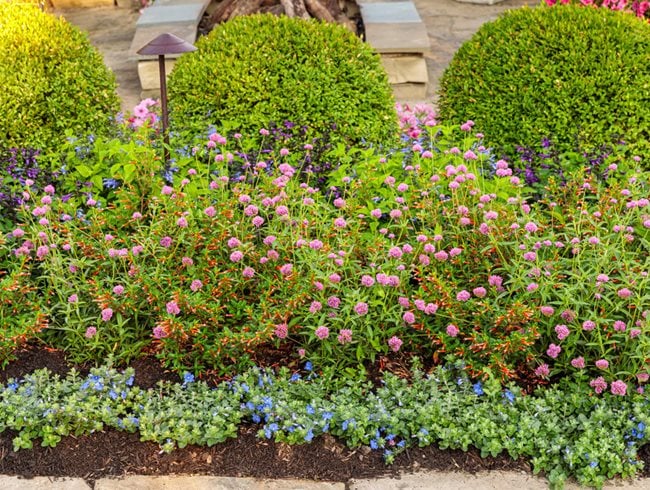Grow Gomphrena Flowers for Long-Lasting Color
Get growing and care tips for this easy-care summer annual, along with ideas for using it in the garden. Published 8/3/2022
Truffula™ Pink globe amaranth (Gomphrena pulchella). Photo by Proven Winners.
Gomphrena (also known as globe amaranth) is one of those flowers with such irresistible charm that you’ll be looking for opportunities to use it everywhere in your garden. This old-fashioned annual produces a plethora of pompom-like blooms all summer long and works equally well in container arrangements, garden beds, and borders to provide long-lasting color and interest.
This sun lover is heat and drought tolerant, too, and requires little maintenance once established. And if you like to grow your own cut flowers, globe amaranth is one of the best. The more you cut it, the more it blooms, and when dried, the flowers hold onto their color indefinitely.
On this page: Basics | Planting | Care | Varieties of Gomphrena | Frequently Asked Questions | Design Ideas
On this page:
- BASICS
- PLANTING GOMPHRENA
- GOMPHRENA CARE
- VARIETIES OF GOMPHRENA
- FREQUENTLY ASKED QUESTIONS
- DESIGN IDEAS
BASICS
Botanical name:
Gomphrena spp.
Common names:
Globe amaranth, globe flower, bachelor’s button (a nickname shared by several different plants)
Plant type:
Annual
Exposure:
Full sun
Bloom time:
Early summer until frost
Height:
Varies by type, ranging from dwarf cultivars that grow 6 to 8 inches tall to others, such as ‘Fireworks’, that can grow as tall as 4 feet.
Flower colors and characteristics:
Clover-like flowerheads are actually made up of colorful bracts (modified leaves that resemble petals) in shades of purple, pink, red, orange, or white. The true flowers are tiny and barely perceptible, but if you look closely you’ll see them peeking out from between the papery bract layers.
Foliage:
Typically narrow and elliptical, varying in color from deep green to blue-green.
HOW TO PLANT GOMPHRENA
Where to plant:
Grow in a site that receives full sun (at least 6 hours of direct sunlight daily). Although Gomphrena can tolerate partial shade, the flowers won't be quite as abundant.
When to plant:
Set out bedding plants 2 to 3 weeks after the last spring frost date. If growing from seeds, start them indoors 6 to 8 weeks before the last spring frost or scatter them directly in the garden once the soil has warmed up, covering them with a thin layer of fine soil.
Soil:
Plant in average, well-drained soil. Globe amaranth isn't picky when it comes to soil type, and will even tolerate poor or sandy soil as long as it has good drainage.
Plant spacing:
Globe amaranth doesn’t like to be crowded, so allow sufficient elbow room between plants to ensure good air circulation. When growing in masses, space plants at least a foot apart.
GOMPHRENA CARE
Water:
Although drought tolerant once established, Gomphrena will benefit from extra hydration during prolonged dry spells. Water whenever the top inch of soil feels dry to the touch, taking care to water plants at the soil line to keep the leaves dry and prevent fungal diseases.
Amendments and fertilizer:
This light feeder doesn’t need much fertilizer to thrive. Incorporating some compost or other organic matter into the soil at planting time will usually provide enough nourishment for a summer’s worth of blooms. If the quality of your garden soil is poor, mix a slow-release granular fertilizer into the soil for an extra nutritional boost.
For container-grown plants, use a high-quality potting mix containing a continuous-release plant food. Be careful not to over-fertilize, which will encourage the plant to produce more foliage instead of flowers.
Pruning and deadheading:
Globe amaranth does not need pinching or deadheading to put on a continuous show of blooms. However, if you want to encourage bushier growth, especially when growing taller varieties, you can pinch back plants by about half early in the growing season, cutting the stems just above a set of leaves. Snipping off the blooms for use as cut flowers will also encourage branching and promote a new flush of blooms later in the season.
Pests and diseases:
Resists most common insect pests, as well as deer and rabbits. Powdery mildew and leaf spot can sometimes be problems, especially if there is poor air circulation between plants. (Find more deer-resistant annuals and perennials.)
VARIETIES OF GOMPHRENA
FREQUENTLY ASKED QUESTIONS
Is Gomphrena an annual or perennial?
Although it can be grown as a perennial in mild climates (zones 9-11), it is treated as a warm-season annual elsewhere. (See: Understanding the Difference Between Annual and Perennial Plants.)
Can I grow globe amaranth from seed?
Yes, Gomphrena is easy to propagate from seed. However, the germination rate is low, so if you are planting seeds in the spring, sow them evenly and generously. You can thin out the seedlings later when they reach a height of 1 to 2 inches. (Learn more about growing your own plants from seed.)
How do I dry globe amaranth flowers?
Harvest the blooms after the flowers have fully opened and strip the leaves from the stems. Tie the bare stems in bunches and hang the flowers upside down to dry in a well-ventilated place, out of direct sunlight. Once dried, the flowerheads are great additions to floral arrangements and craft projects. The following spring, you can crush the dried flowers and toss them into the garden to release the seeds for another season of blooms.
Are globe amaranth plants toxic?
No. In fact, all parts of the plant are edible and pose no threat to people or animals. The flowers are sometimes used to brew teas that are said to have anti-oxidant and medicinal properties.
Is globe amaranth invasive?
No. Although Gomphrena may self-seed under the right conditions, the seedlings are easy to remove from areas where they are unwanted. Not to be confused with the larger Palmer amaranth (Amaranthus palmeri) which has been ruled invasive in many areas.
IDEAS FOR USING GOMPHRENA

Use in container gardens as a tall accent plant, combining it with a mounding plant, such as verbena or calibrachoa, for a full, lush look. (See this colorful container recipe). Photo by Proven Winners.

Grow in the cutting garden for use in both fresh and dried flower arrangements. (Shown: Truffula® Pink globe amaranth combined with blue angelonia and Suncredible® yellow sunflowers.) Photo by Proven Winners.

Plant in a pollinator garden, along with other sun-loving annuals and perennials that are highly attractive to bees and butterflies. (See this pollinator garden landscape design). Photo by Proven Winners.

Plant taller, airier cultivars in borders among other sun lovers, such as salvia and firecracker plant, to add texture and movement. Because globe amaranth is loaded with flowers from planting time until frost, you won’t need many plants to make a big impact. Photo by Proven Winners.

Use to add vibrant color and whimsical beauty to an informal cottage-style garden, along with other traditional cottage garden favorites. (Try this cottage garden combination.) Photo by Proven Winners.









